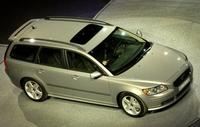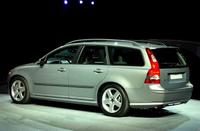Car Review: 2005 Volvo V50 T5 AWD
DRIVING DOWN THE ROAD
WITH CAREY RUSS
The Volvo S40 sedan and V40 wagon were pleasant small, sporty, semi-luxury cars when they were introduced to the American market in 1999, and they did well, attracting new, younger buyers to the Volvo fold. But there was a tiny problem - while new to North America, the S40 and V40 were old hat in Europe, having been around since 1995. Products of a joint venture with Mitsubishi, they shared little with other Volvos. They were a fine solution to the problem of cost-effective creation of entry-level Volvos in the mid-90s, but cars can age quickly, and the politics of the auto industry can change even faster. Since those days, Volvo Cars has been bought by Ford, and Mitsubishi is in the DaimlerChrysler camp. What could be politically-expedient between Volvo and Mitsubishi would not necessarily be so between Ford and DaimlerChrysler.
And besides, the 40-series was showing its age, something to be expected of a car approaching ten years old. Where to go for a replacement? There was bound to be something in the vast Ford family of vehicles, and that was found in the platform beneath the Mazda3 and upcoming Ford Focus. The S/V40's 1.8-liter turbocharged four-cylinder engine was unique to that series, and aging, so where to go for power? Well, Volvo has a perfectly good series of five-cylinder engines used in its other cars....
And so the 2005 S40 sedan and V50 wagon were born. (The numbering is in Volvo's current system of even first digit for sedans and odd for wagons or SUVs.) But don't think of either as a rebadged Mazda3 or Focus. ``Platform sharing'' is to be taken loosely here. I asked a Volvo representative about the S40/V50 underpinnings, and he replied as follows: ``We use some of the same mounting points and stampings, but we have different materials - four different types of steel, used depending on use, load, and safety factors - so very little is interchangeable.'' Drivetrains are completely different, and completely Volvo. The choice is between two twin-cam five-cylinder engines, a 2.4-liter naturally-aspirated one in the 2.4i and a 2.5-liter light-pressure turbo in the T5. Both of those cars are front-wheel drive; the T5 AWD is all-wheel drive, with Volvo's own system.
I've been driving a V50 T5 AWD for the past week. I have fond memories of the old V40, but it was a very different car than the large Volvos of its time. The V50 is much closer to the rest of the Volvo range in styling and appointment, with some unique features. It is far advanced over the V40 in every way, and, except for its smaller size, feels like any of the current larger Volvos. The driving experience is more sporty than sports, although that may change (Volvo has just shown a V50 concept car with a 340-hp version of the S60 R engine, but don't expect it in showrooms any time soon). The comfort and utility are pure Volvo, and put the V50 at the head of its class.
APPEARANCE: There is absolutely no doubt that the V50 is a Volvo. The design language that debuted on the S80 in 1997, and has since been developed on the V70, S60, and XC90, is taken to a new extreme on the V50's exterior. It's almost as high but much shorter than the V70, so its proportions are very different, and very compact. At the front, the broad-shouldered look given by the domed hood and low, wide front fenders is enhanced by the protruding small trapezoidal grille. Much like the V70, the roofline gently descends toward the rear. Also for lower aerodynamic drag, and as on the V70, the body becomes slightly narrower toward the rear, with the side windows becoming more vertical. At the back, the taillights, which cover the entire area to the side of the tailgate from just above the bumper to the roof, dominate.
COMFORT: If the V50's exterior is an evolution of recent Volvo styling trends, its interior is a revolution. Scandinavian Modern design at its finest - check out the central control panel. It's a free-standing, brushed-aluminum (wood optional) piece that looks to be sourced from a high-end Scandinavian stereo manufacturer. Elegantly-designed and functional, it has simple controls for the audio system on top, with Volvo's iconic climate controls beneath. There is a storage space to the front, behind it from the passengers' point of view. There is matching aluminum trim on the doors around the window lifts - and it's real aluminum, not the plastic that is common in the sport-compact class. The ``simple and functional'' theme is carried over to the rest of the instrument panel, with twin metal-bezeled gauges under a hood in front of the driver. There is no conventional key, the plastic keylike electronic device docks to a spot between the control panel and the manually-adjustable tilt-and-telescope leather-rimmed steering wheel. The standard seats, with cloth center sections and leatherette side bolsters, are not the same design as found in larger Volvos, but they are as comfortable. You want utility and versatility? Not only do the rear seat cushions and back flip and fold 60/40, the front passenger seat folds forward and flat to handle long items. Volvo calls the V50 an ``active-lifestyle sportwagon,'' and if your active lifestyle includes bicycles, camping gear, climbing gear, snowboards, or even windsurfing, its hardware can fit inside. If your lifestyle includes small trailers, the V50 can tow up to 2,000 lbs.
SAFETY: Viva! All V50 and S40 models benefit from ``Volvo's Intelligent Vehicle Architecture,'' which uses computer-modeled design with four grades of steel for a rigid chassis with high occupant protection and progressive, controlled deformation in the event of a crash. Naturally, all of Volvos safety systems for front and side impact protection are standard equipment.
RIDE AND HANDLING: The V50 T5 AWD comes with the ``Dynamic Sport Suspension,'' which means springs and shocks tuned a little firmer than standard. It's a ``European sport-touring sedan'' tuning, not serious sports, so there is a little less body roll in hard cornering and comfort levels are still high. Volvo's all-wheel drive system has a pronounced static front-wheel drive bias - 95% - for familiar driving characteristics, and apportions torque rearwards automatically as needed. It only weighs 130 lbs, so its impact on acceleration, braking, and handling is minimal.
PERFORMANCE: Transversely-mounted under the V50 T5's hood is found the 2.5-liter low-pressure turbocharged version of Volvo's dual overhead cam inline five-cylinder engine. Maximum horsepower is 218 and maximum torque is 236 lb-ft, which mean good performance with the car's 3,400-lb weight. But what really makes the T5 an easily-drivable car are two things: turbo boost is light and the compression ratio is quite high for a forced-induction engine at 9.0:1 so there is little difference in power off or on boost and no sudden overpowering rush, and maximum torque is developed from 1500 to 4800 rpm - meaning that it's available at nearly all times. So it works very well with the optional five-speed automatic transmission with which my test car was equipped. ``Geartronic'' manual-shift mode comes with the automatic, and the engine's torque band is so broad that one gear is all that is necessary on most roads - and that gear, I discovered, could often be one higher that I thought, for better fuel economy. A six-speed manual transmission is standard, and would be the choice for a sport-oriented driver.
CONCLUSIONS: The new Volvo V50 combines style, versatility, safety, and performance.
SPECIFICATIONS
2005 Volvo V50 T5 AWD
Base Price $ 28,910
Price As Tested $ 33,290
Engine Type dual overhead cam turbocharged inline
5-cylinder
Engine Size 2.5 liters / 154 cu. in.
Horsepower 218 @ 5000 rpm
Torque (lb-ft) 236 @ 1500-4800 rpm
Transmission 5-speed electronically-controlled
automatic
(6-speed manual standard)
Wheelbase / Length 103.9 in. / 177.7 in.
Curb Weight 3,399 lbs.
Pounds Per Horsepower 15.6
Fuel Capacity 15.1 gal.
Fuel Requirement 91 octane unleaded premium gasoline
Tires 205/50 VR17 Michelin Pilot MXM4
Brakes, front/rear vented disc / solid disc,
antilock standard
Suspension, front/rear independent MacPherson strut /
independent multilink
Drivetrain front engine, all-wheel drive
PERFORMANCE
EPA Fuel Economy - miles per gallon
city / highway / observed 19 / 26 / 21
0 to 60 mph 6.9 sec
Towing capacity 2,000 lbs
OPTIONS AND CHARGES
Metallic paint $ 450
Premium sound system with 6-CD player $ 850
Automatic Transmission with
Geartronic manual mode $ 1,200
Dynamic Stability and Traction Control $ 695
17-inch SAGITTA alloy wheels $ 500
Destination charge $ 685




